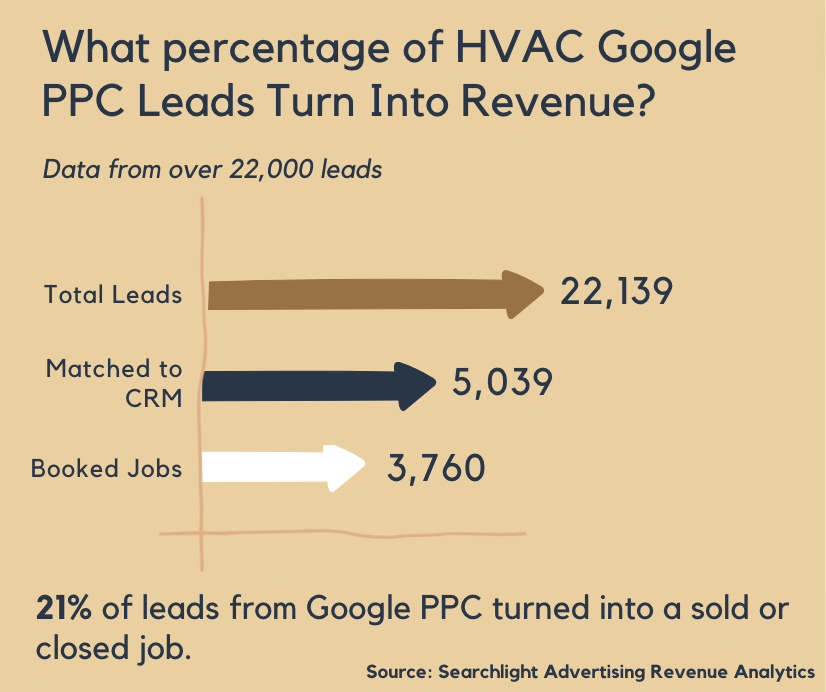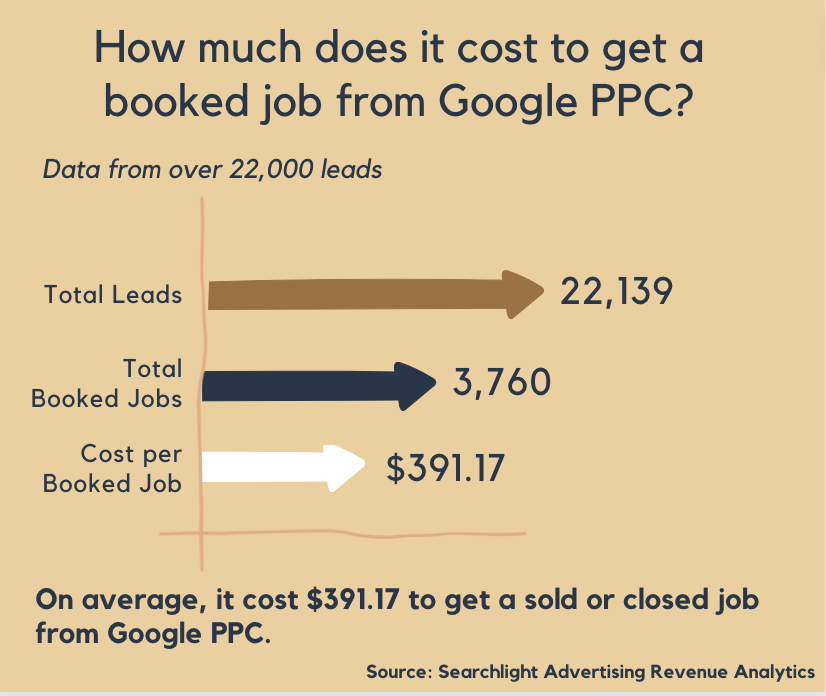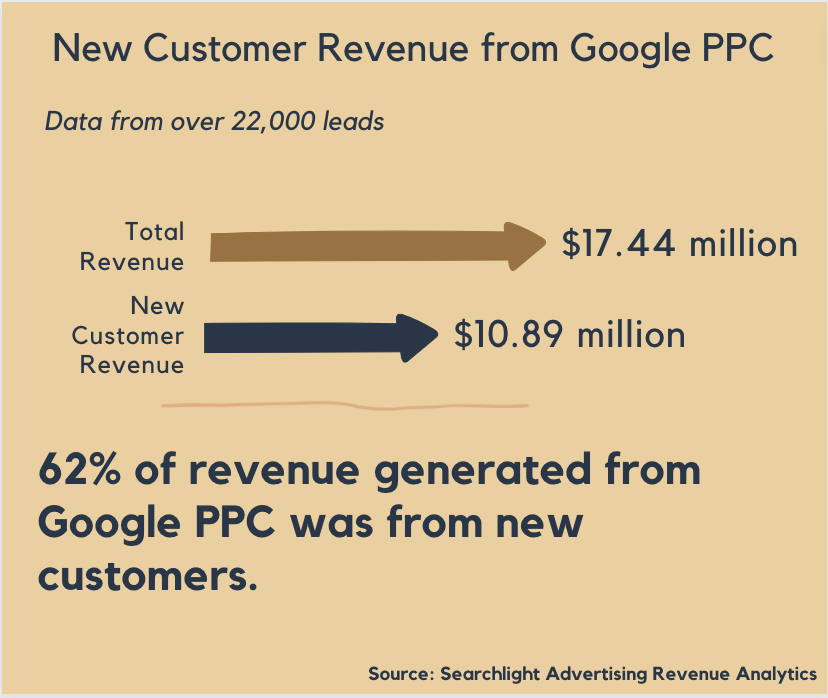Digital channels are frequently talked about as a necessary component of modern HVAC marketing strategies, but most of the business impact is measured with KPIs like cost per lead and total lead volume. You might even find yourself asking your marketing vendors for more lead volume to boost revenue.
The problem with cost per lead and lead volume is that it doesn’t tell the full story. You need to know how well those leads convert to revenue, which will help determine if your marketing vendor needs to improve, if your team handling the leads need to improve, and if you are spending on the right channels.
As more digital channels become available (Google and Bing PPC, Facebook, YouTube, Nextdoor, and even TikTok), understanding how customers convert and what revenue those channels bring in can make your marketing investment decisions easier.
There are a lot of opinions about Google PPC specifically, but a lot of them talk about how expensive it’s gotten based on cost per click and cost per lead. We looked at data from more than 22,000 Google PPC leads to see how well they converted to revenue to help you make better marketing investments. The data found throughout this article is from November 2021 to June 2022 across multiple HVAC companies throughout the U.S.
The metrics we use to measure the impact of Google PPC include:
- Total Leads
- Matched to CRM + Match Rate
- Booked Jobs + Booked Job Rate
- Cost per Booked Job
- Average Ticket
- Return on Ad Spend
Note: We did not break out Google click-to-call versus website-to-call in this case study. If you’re curious about that data, you can find it here.
Let’s dive in.

Click chart to enlarge
What Percentage of Google PPC Leads Converted to Revenue?
We view lead to revenue as a flow.
A lead comes in, it gets entered into the CRM, the customer usually has a service appointment or sales consultation, followed by estimates. Then the job is sold and the work is completed then closed out.
We measure each step in this flow to figure out where revenue gets stuck and what you can do about it.
Our data found that 21% of Google Ad leads converted to revenue (sold or closed jobs). We call this the Booked Job Rate. For every 100 leads that come in from Google, the average across the 22,000+ leads measured showed that 21 of them turned into a sold or closed job. Remember that this is just a benchmark — booked job rates can be improved (we’ve seen it reach 30%) by improving your lead handling processes across phone, form, chat, and scheduling tools.

Click chart to enlarge
How Much Does It Cost to Acquire a Paying Customer from Google PPC?
In addition to looking at the booked job rate, we also look at the average cost per booked job.
Instead of measuring how much it costs to get a lead, we measure how much it costs to get a paying customer. We found that it cost $391.17 per booked job with Google PPC across 22,000+ leads.
The average ticket from those converted leads was $4,637.77. That’s a 11.85x return on ad spend, meaning for every $1 spent on Google for those leads, $11.85 was generated in return.
You can reduce your cost per booked job by improving match rates and booked job rates (through ad strategy, phone presence, and lead handling).

Click chart to enlarge
How Well Do Google PPC Leads Match to New Opportunity in the CRM?
Across 22,000+ leads, 28% of them matched to a new opportunity in the CRM.
When a lead comes in, we automatically track if that customer is in the CRM and if they have a new job record after the lead came in. That includes service appointments, sales consultations, open estimates, sold jobs, and closed jobs. We call this metric Match Rate, and it tells us about the quality of inbound leads from Google PPC.
For every 100 Google PPC leads, you could expect 28 of them to end up in the CRM with an opportunity to close business. Using this as a progression, the data showed that 28% of leads matched to new opportunities in the CRM, 21% of leads booked a job, and it cost $391.17 to get a customer who spent an average of $4,637.77.
The Data Also Showed That Google PPC Is Effective at Driving New Customer Revenue
This data is really helpful, but you may be wondering how much revenue driven by Google PPC came from customers who had not spent money with your business before.
62% of the revenue driven by Google PPC in this dataset came from new customers. Out of the $17.44 million in revenue that the 22,000+ leads from Google PPC drove, $10.89 million of that was from new customers.
The amount of new customer revenue driven by Google PPC is based on the strategy your vendor has implemented, but if you’re able to measure the data, you can work with them to put a focus on unbranded searches (“a/c install near me”) and new market areas.
The average ticket for new customers who converted via Google PPC was $5,962.17, which is more than $2,500 higher than existing customers ($3,385.57).
How to Use This Data to Improve Your HVAC Marketing Strategy
Now that you’re armed with some benchmarks for how Google PPC performs in terms of revenue, not leads, you can begin to make some strategy and operational adjustments.
If you haven’t invested in Google PPC, the data provides a pretty compelling case for you to start spending on the channel.
You’ll want to work with your marketing vendor to focus on acquiring new customers by putting more budget toward unbranded search terms like “a/c repair near me” or “a/c installation near me” versus spending the majority of your budget on your business name.
You should also consider re-evaluating how your teams handle leads across all conversion tools. For example, who on your team is responsible for following up with form leads, and what does that response look like?
In this data, 28% of form leads from Google PPC matched to new opportunities in the CRM, but that still left 1,146 forms that did not match to new work in the CRM. Consider first improving the match rate and booked job rates on existing leads before spending additional money to get more leads.
We previously wrote about how to grow your contracting business by perfecting your phone presence, and we meant it. One of the best ways to improve revenue performance from marketing channels is to improve how well your teams convert leads into opportunities.
At the very least, you can use these new metrics (with benchmarks) to ask your marketing vendor to provide yours so that you can start re-evaluating where you spend, how much you spend, and how well your operations process handles the inbound leads.


Report Abusive Comment